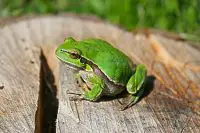Green frog (Lithobates clamitans) belongs to the family of true frogs called Ranidae, that are most widely distributed among all families of frogs. Its scientific name is a blend of Greek and Latin words. The word Lithobates is a combination of two words: ‘litho’ and ‘bates’ and the literal meaning is “A stone and one that walks”. The word clamitans literally means “loud calling”.
There are two subspecies of this frogs: the northern green frog and the bronze frog.
Male green frogs are smaller than the females while the color of their throats is bright yellow. There are prominent furrows (wrinkles) on the skin of these frogs. These skin folds are present on the dorsal side (back) of this frog. The color at the back may be greenish-brown while small brown blotches are sprinkled over it. The tadpoles have olive-green shade from above while yellowish-white from the underside.
Green frog is a medium-sized frog. It has a length range of 5 to 10 centimeters and weighs around 28 to 85 grams. The size of a tadpole is 74 to 100 millimeters.
medium-sized frog. It has a length range of 5 to 10 centimeters and weighs around 28 to 85 grams. The size of a tadpole is 74 to 100 millimeters.
Breeding occurs between April and June. These frogs breed in freshwaters. Male frogs reach maturity at the age of 1 year while females get mature at 2 to 3 years.
A female green frog lays a clutch size of 1,000 to 7,000 eggs and 2 clutches per season. These eggs are glued to the aquatic plants.
These frogs originally belong to Virginia. They are found in Canada and eastern United States.
Green frogs occupy semi-permanent freshwater streams, marshlands, water channels alongside the roads and other shallow lakes. They spend all their life in water.
Green frogs eat a wide variety of small creatures. They are usually found to prey on spiders, shrimp, snails, small fish and snakes, crayfish, insects and tadpoles. They also feed on aquatic vegetation and algae.





